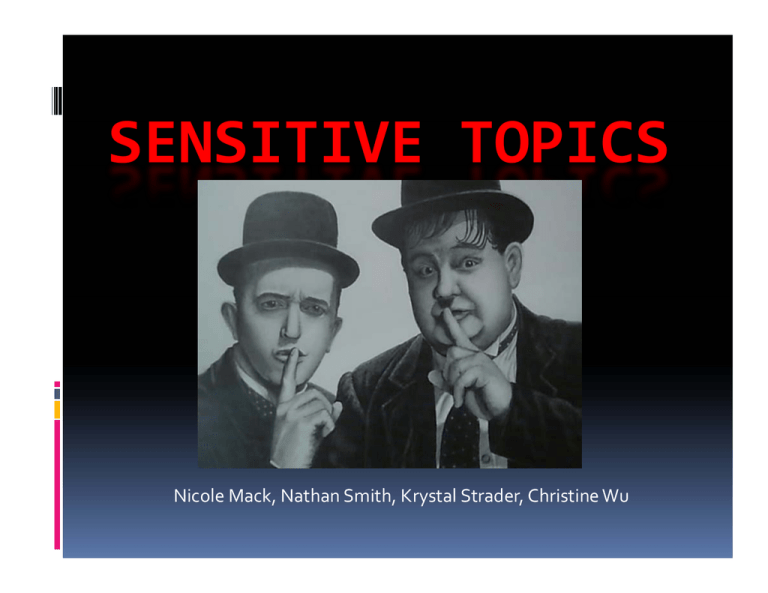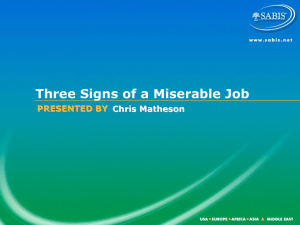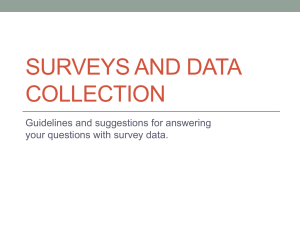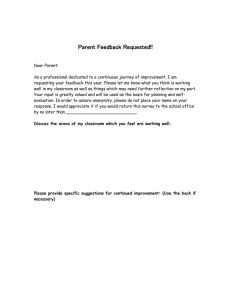Sensitive Topics
advertisement

SENSITIVE TOPICS Nicole Mack, Nathan Smith, Krystal Strader, Christine Wu Introduction What are Sensitive Subjects? Sensitive Subjects/Topics are those dealing with issues in which we wish to keep private including receipt of welfare, income, alcohol and drug use, criminal history, and some “embarrassing” medical conditions. SOURCE: Marquis et. Al 1986 Concerns with Sensitive Topics Protection of Human Subjects Confidentiality and Anonymity Timing of the Survey Reporting Issues Interviewer salience Presentation of Questions ANONYMITY VS. CONFIDENTIALITY DEFINITIONS Anonymity: the quality or state of being… 1) Not named or identified 2) of unknown authorship or origin 3) lacking individuality, distinction, or recognizability Confidentiality: the quality or state of being… 1) marked by willingness to confide 2) private, secret 3) entrusted with confidences 4) containing information whose unauthorized disclosure could be prejudicial to “national” interest. Source: Merriam Webster Online Dictionary LEVELS OF PRIVACY Anonymity More Private Confidentiality Less Private NONE LEVELS OF PRIVACY Cont.. LEVEL ONE: NONE “answer to a question can be linked to an individual and their identity/answer is available to persons OTHER than researcher” LEVEL TWO: CONFIDENTIALITY “answer to a question can be linked to an individual, but their identity/answer is NOT available to persons other than researcher” “people outside project cannot know if an individual participated” Hernandez et. al LEVELS OF PRIVACY Cont.. LEVEL THREE: ANONYMITY “nobody knows whether or not an individual participates”…including the researcher “cannot match individual to answer because the researcher does not know if the individual was in or out of the study” Hernandez et. al EXAMPLE Research: 155 students enrolled in a university level psychology class were given a survey including the following question of interest: “In the past year, have you ever, even once, used unapproved material on an exam, quiz, or any other form of test?” Ong and Weiss 2000 Results: Ong and Weiss 2000 Implications: The research discussed above supports the hypothesis that anonymity “induces” more revelations to sensitive topic questions, and therefore, anonymity and confidentiality should not be viewed as interchangeable (Ong and Weiss 2000). In contrast, other research (Roland and Genevieve 2002) comparing total anonymity and lack thereof (confidentiality) found no significant difference in mean self‐reports regarding drug use in the past 12 months. à These researchers suggest that the presence or absence of total anonymity does not matter if respondents are convinced that the data will be kept confidential. Discussion What do you think? SUMMARY: Confidentiality PROS: • Researcher can trace information back to the source Cons: • Biased information • Reliability • Protects sensitive information Hernandez et. al SUMMARY: Annonymity PROS: • Protects privacy • Assists in attaining un‐ biased information Cons: • Reliability • Information cannot be traced back to source • Increases willingness to provide information Hernandez et. al DISCUSSION Main Issue with Sensitive Topics Questions of accuracy of the data collected Influences of “socially correct” answers Foreseeable negative consequence will motivate less truthful responses Differences of individual reactions to sensitive topics Question Design for Sensitive Topics Use Open Questions Use Long Questions Use Familiar Words Embed the Questions Mail Surveys Mail surveys are particularly useful when the survey solicits sensitive information Respondents are reluctant to tell a live interviewer how much they earn or their opinion on a controversial issue (Polaris Market Research, 2009) Web Surveys A significant number of people will give more honest answers to questions about sensitive topics, when giving their answers to a computer, rather than to a person or on paper. (Macorr Inc., 2009) Telephone Surveys Groves and Kahn (1979) indicated that telephone respondents are less candid about sensitive topics Hochstim (1967) and Colombotos (1969) have argued that respondents will report more honestly on intimate and personal subjects in telephone surveys than in face to face surveys‐ “social desirability effect” Never Have I Ever Survey Responses Sent from an unknown Sent from a credible source 2 responses out of 8 source 5 responses out of 8 Non‐responses / Misreporting Unit Non‐response‐ complete refusal to participate Item Non‐response‐ refusal to answer specific questions Issues of underreporting‐ avoiding extremes Issues of over reporting‐ admitting to have done something even though you have not Changes in Survey Research • Development of applied probability sampling • Telephone interviewing • New approaches to statistical analysis • Greater understanding of nonsampling bias and error • Appreciation of cognitive psychology principles in questionnaire design Most Significant Change in Survey Methodology The application of computer methods to survey data collection and capture. COMPUTER‐ASSISTED SURVEY COLLECTION (CASIC) The use of computers for survey data collection, data capture, and data preparation. Enhancing Interview Methodologies Computer-Assisted Personal Interviewing Computer-Assisted Telephone Interviewing Audio Computer-Assisted Self Interviewing Telephone Audio Computer-Assisted Self- Interviewing Computer-Assisted Recorded Interviewing Web-Based, Computer-Assisted Data Entry Methods pioneered by RTI Model of the effects of different methods of in‐ person data collection on responses to sensitive data (Couper et al., 1998, 436) Model of the effects of different methods of in‐ person data collection on responses to sensitive data (Couper et al., 1998, 436) Audio-CASI May be used with any respondent who can hear, but does NOT require literacy. May be programmed in ANY spoken language. Standardizes the presentation. Automated skip patterns. Provides automated consistency. Critical Advantages of CASI in Sensitive Topics Surveys g Sensitive Topics Surveys Quality of data Randomized Response Technique: What is it? • Randomized response is a research method to measure the behavior, opinions or attitudes of respondents towards sensitive topics, like breaking the law, the use of drugs and alcohol or sexuality. • This method was first introduced by Stanley L. Warner in 1965 and has since been modified or redeveloped into similar methods RRT: How it works • Interviewee is given a randomization device (i.e. dice, colored marbles, coins, spinner) and a set of statements A (with probability p) and B (with probability 1‐p) • Using the device and without revealing to the interviewer which statement was selected by the device, the respondent answers true or not according to his attitude toward the issue at hand • Survey properties used: SRS w/ replacement RRT: Other Methods There are several other modifications of the RRT including: à Unrelated Questions Method à Forced Response/Contamination Method à Unmatched Counting Technique Class Activity Flip your coin Heads: Answer yes. Tails: Have you ever cheated on a test? For more information, visit the website http://www.jstor.org/stable/2283137?seq=2 RRT: Issues and Concerns Estimates are statistically inefficient Respondents continue to be somewhat apprehensive of being stigmatized RRT: A Meta‐Analysis Multilevel analysis with three levels (studies, conditions, and sensitive items) was used to compare the effects of data collection methods (face‐to‐face, self‐administered, telephone, etc. )across different studies Goals of Meta‐Analysis: à Do RRTs in general produce more valid population estimates for sensitive topics than conventional question–answer designs like face to face interviews, self‐administered questionnaires, telephone interviewing and computer assisted interviewing (CASI)? à Why are the RRT results so variable across studies? à Do comparative studies provide the same information as individual validation studies? Meta Analysis (cont’d) • Concluded that RRT method showed less discrepancies between observed characteristic and known population value as compared to direct questioning (for both individual study and comparative studies) • RRT is more robust against fluctuations in social sensitivity of topic • One problematic factor is large amount of unexplained variance between condition and studies • For the future the researchers recommend establishing a best practice procedure to study quality aspects of the data collection process in RRT Final Thoughts Let’s revisit the “Never Have I Ever “ Survey… Never Have I Ever Survey Works Cited http://www.randomizedresponse.nl/Download/Metaanalyse.pdf http://ablejec.nib.si/STAT100/STAT100/STAT100‐060322.pdf http://www.jstor.org/stable/2283137?seq=2 Hernandez, P., Kim, J., & Ruedo, G. (2009). Confidentaility vs. Anonymity. Retrieved Mar. 21, 2009, from http://web.pdx.edu/~grueda/files/Conf_Anonymity.pdf Marquis, K. H., Marquis, M. S., & Polich, J. M. (1986). Response Bias and Reliability in Sensitive Topic Surveys. Journal of the American Statistical Association, 81(394), 381‐389. Merriam Webster, Incorporated. (2009). Merriam Webster Online Dictionary. Retrieved Apr. 20, 2009, from http://www.merriam‐ webster.com/dictionary/ Moore, R. S. & Genevieve, M. A. (2002).Survey confidentaility vs. anonymity: Young men's self‐reported substance abuse. , , . Ong, A. D. & Weiss, D. J. (2000). The Impact of Anonymity on REsponses to Sensitive Questions. Journal of Applied Psychology, 30(8), 1691‐1708. Works Cited (Cont) http://www.macorr.com/internet_surveys.htm http://www.polarismr.com/Whatsnew_Methodol ogies_WebMailIVR.html http://books.google.com/books?id=8W5e6uBzFf IC&pg=PA291&lpg=PA291&dq=sensitive+topics, +mail,+email,+web+survey&source=bl&ots=Jo0_ u8Ft1U&sig=sK63q6eDhOAtRBOzwko08_Jx‐ B8&hl=en&ei=ouvtSaG1OsqEtweWoI3FDw&sa= X&oi=book_result&ct=result&resnum=4#PPA26 1,M1


